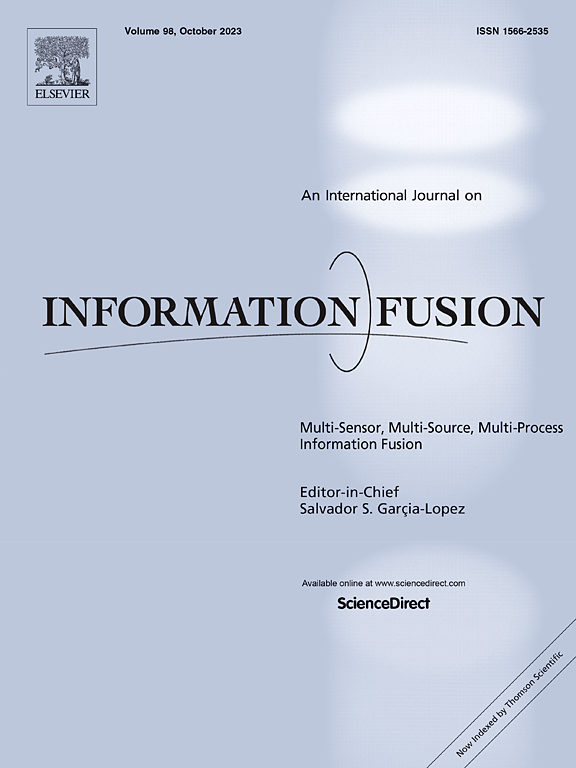Multi-scale dual-attention frequency fusion for joint segmentation and deformable medical image registration
IF 14.7
1区 计算机科学
Q1 COMPUTER SCIENCE, ARTIFICIAL INTELLIGENCE
引用次数: 0
Abstract
Deformable medical image registration is a crucial aspect of medical image analysis. Improving the accuracy and plausibility of registration by information fusion is still a problem that needs to be addressed. To solve this problem, we propose DAFF-Net, a novel framework that systematically unifies three kind of information fusion (low-level fusion, high-level fusion, and loss fusion) to enhance registration precision and plausibility: (i) low-level fusion: DAFF-Net employs a shared global encoder to extract common anatomical features from both moving and fixed images in two tasks, reducing redundancy and ensuring foundational consistency across tasks; (ii) high-level fusion: through the dual attention frequency fusion (DAFF) module, DAFF-Net dynamically combines multi-scale registration and segmentation features, leverages features of low-frequency structural coherences and high-frequency boundary details, and adaptively reweighting them to enhance registration via global and local attention mechanisms; (iii) loss fusion: a unified loss function enforces bidirectional consistency, i.e., segmentation supervises registration through anatomical constraints, while registration refines segmentation via deformation-correct anatomical consistency. Extensive experiments on three public 3D brain magnetic resonance imaging (MRI) datasets demonstrate that the proposed DAFF-Net and its unsupervised variant outperform state-of-the-art registration methods across several evaluation metrics, demonstrating the effectiveness of our approach in deformable medical image registration. The proposed framework holds promise for practical clinical applications such as preoperative planning, longitudinal disease tracking, and structural analysis in neurological disorders.
多尺度双关注频率融合关节分割与形变医学图像配准
形变医学图像配准是医学图像分析的一个重要方面。通过信息融合提高配准的准确性和可信性仍然是一个需要解决的问题。为了解决这一问题,我们提出了一种新的框架DAFF-Net,该框架系统地统一了三种信息融合(低水平融合、高水平融合和损失融合),以提高配准精度和可信度:(1)低水平融合:DAFF-Net采用共享的全局编码器从两个任务中的运动和固定图像中提取共同的解剖特征,减少冗余并确保任务间的基本一致性;(ii)高水平融合:DAFF- net通过双注意频率融合(dual attention frequency fusion, DAFF)模块,动态结合多尺度配准和分割特征,利用低频结构相干和高频边界细节特征,自适应地重新加权,通过全局和局部注意机制增强配准;(iii)损失融合:统一的损失函数实现双向一致性,即分割通过解剖约束监督配准,而配准通过形变正确的解剖一致性对分割进行细化。在三个公开的3D脑磁共振成像(MRI)数据集上进行的大量实验表明,所提出的DAFF-Net及其无监督变体在几个评估指标上优于最先进的配准方法,证明了我们的方法在可变形医学图像配准方面的有效性。提出的框架具有实际的临床应用前景,如术前计划,纵向疾病跟踪和神经系统疾病的结构分析。
本文章由计算机程序翻译,如有差异,请以英文原文为准。
求助全文
约1分钟内获得全文
求助全文
来源期刊

Information Fusion
工程技术-计算机:理论方法
CiteScore
33.20
自引率
4.30%
发文量
161
审稿时长
7.9 months
期刊介绍:
Information Fusion serves as a central platform for showcasing advancements in multi-sensor, multi-source, multi-process information fusion, fostering collaboration among diverse disciplines driving its progress. It is the leading outlet for sharing research and development in this field, focusing on architectures, algorithms, and applications. Papers dealing with fundamental theoretical analyses as well as those demonstrating their application to real-world problems will be welcome.
 求助内容:
求助内容: 应助结果提醒方式:
应助结果提醒方式:


